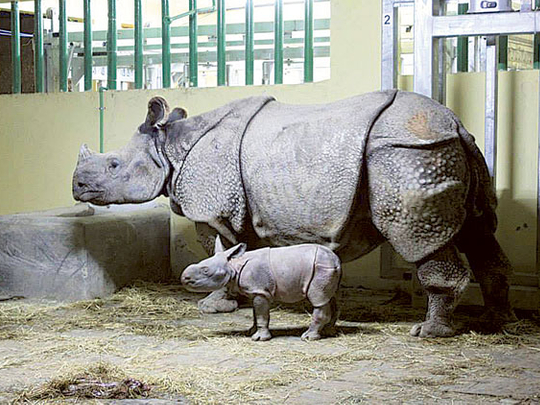
Sharjah: The Al Bustan Zoological Centre in Sharjah welcomed its first baby Indian rhino last week, believed to be the first Indian rhino birth in the Middle East.
A 58-kilogramme male Indian rhinoceros, also known as Greater One-Horned Rhino (Rhinoceros unicornis), was born on October 13 at 8.41pm at the non-commercial zoo in Sharjah. His mother, Asha, carried him for 470 days and gave birth to the baby rhino unassisted, after being in labour for three hours.
“Everything happened so fast. Asha did it all on her own but all the veterinarians were on standby,” Kate Burns, the centre’s veterinary nurse, told Gulf News.
“The baby rhino is doing very well and is very playful. He is a joy to watch,” she added.
The baby rhino, which is yet to be named, was received with joy at the centre as they claim it is the first successful Indian rhino birth in the region.
“Asha has been pregnant twice before, but both babies died at birth. This is Asha’s first live birth so this is important for Al Bustan. Out of all five rhino species, Indian rhinos are the ones which are most prone to delivering stillbirths in captivity,” Burns said.
The staff of the centre, which is a safe haven and breeding place for threatened species, most of which come from Africa, the Middle East, and South America, said they are ecstatic with the delivery of the newest member of the zoo’s family.
Indian rhinos are listed as ‘Vulnerable’ under the Red List of the International Union of Conservation for Nature, with a total population estimate of just 2,575 individuals as of 2007.
“Rhinos all over the world are struggling with illegal poaching and the use of the horn in eastern medication put all rhinos at great risk. This makes every birth a glimmer of hope,” Meyer de Kock, manager of the centre, told Gulf News.
The baby rhino has now been listed in the Indian rhino Studbook, a global record of the family tree of all existing animals of a selected species maintained by an expert appointed internationally. The centre will take care of the baby rhino until it is mature enough to breed. It will be sent to a breeding centre or zoological institution where it’s needed, with the aim of maintaining the genetic diversity of the species.
But the good news does not end there, Burns said. The month of October proved a fertile period for the centre which also welcomed a baby giraffe and a baby giant eland, adding to the centre’s growing family of more than 800 animal species.












